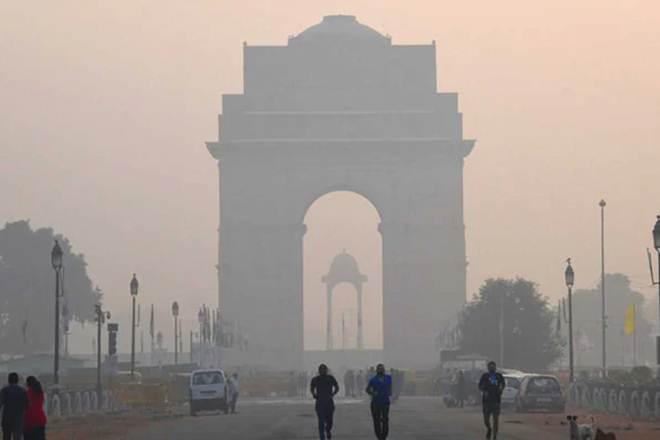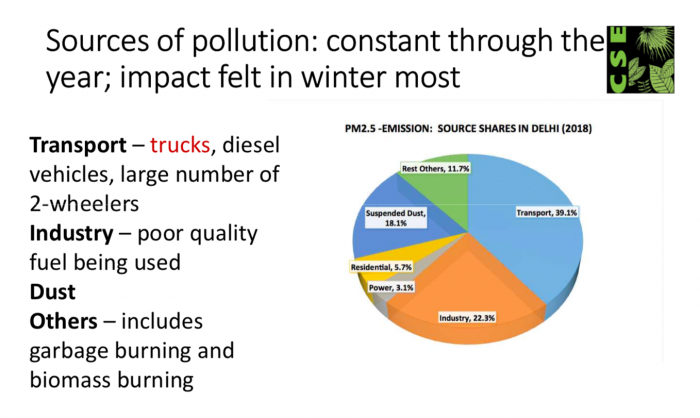Delhi Elections: Is Pollution Crisis a Poll Plank?

Image for representational use only.Image Courtesy : The Financial Express
With worsening Air Quality Index and a landfill bigger than the size of the Taj Mahal, Delhi is now touted as the pollution capital of the world. Pollution that has claimed millions of lives. In the run up to its 70-member state Assembly elections, scheduled to take place on February 8, this is set to become one of the major poll issues.
According to Centre for the Study of Developing Societies (CSDS), every 10 voters will keep in mind the air crisis faced by the city every year. Moreover, nearly half of over 2,000 people surveyed by the CSDS said pollution was a big problem in the city.
Keeping the public interest in mind, the ruling Aam Aadmi Party has issued a 10-point guarantee card, to reduce air pollution to one third of the present levels, planting 2 crore trees, and improving public transportation by bringing in more than 11,000 buses and increasing the metro network. While the Congress is yet to come out with a “green manifesto”, Bharatiya Janata Party has promised an improvement in public transport and the installation of smog towers. However, activists are terming the proposed plans “inadequate”.
Also read: Delhi Elections: BJP Lost in Its Own Labyrinth
Environment lawyer Rahul Chaudhary said, “The Aam Aadmi Party has declared their commitment to work on environmental issues in the next five years, however, none of the three parties have a concrete roadmap to achieve the policy targets. AAP managed to take some steps to control pollution by shifting the centres of pollution generation, such as coal plants. However, shifting them to the outskirts of the city is not enough. The pollution crisis is being handled with a lack of seriousness, while the citizens of Delhi are trying their best to make it an election agenda.”

Pollution big on voter’s minds, while policy remains fragmented
The citizens of Delhi’s residential welfare associations have launched the ‘Citizens Green Manifesto for a Smart and Sustainable Delhi 2020’. The manifesto has been prepared by United Residents Joint Action (URJA) with the motto of making the city cleaner and greener. The demands include 65% reduction in air pollution by 2025 to meet national standards and increasing public transport capacity for 80% of all trips in the city.
The manifesto has been shared with the AAP, Congress, BJP and the Shiromani Akali Dal. According to the NGOs, this green manifesto is a roadmap to tackle pollution at every level in the city – be it air, water or solid waste management. The manifesto seeks reduction in air pollution levels drastically in order to meet the national standards for safeguarding public health. It has also demanded a roadmap by the government in power for zero waste at landfills and strict implementation of waste segregation and solid-waste management rules. They demand that government should adopt the practice of community composting of wet waste in MCD and DDA parks. Along with waste, the manifesto also urged for strict implementation of the ban on single-use plastic in the city. Moreover, the green manifesto also urged for an Income tax rebate for people who use metro or buses for commuting and tax exemptions for restaurants and hotels for promoting eco-friendly products.
Speaking to NewsClick, waste management activist Vikrant Tongad, said, “Our analysis shows while environment is a concern for voters, it is not featuring in a serious way on the agenda of the parties. The discussion on pollution includes issues of water, waste management and air pollution. We are witnessing a climate emergency, however, the environmental agenda looks pushed back. The brunt of this emergency is being borne by the poor people of the city who do not have access to resources to buy clean water or afford air purifiers.”
In its latest move to prevent the pollution crisis, on the directions of the Supreme Court, Delhi is set to install two smog towers in the city, in Connaught Place and Anand Vihar. Smog towers are structures designed to work as large-scale air purifiers. They are usually fitted with multiple layers of air filters, which clean the air of pollutants as it passes through them. In Delhi, project experts estimate that the 20-metre high towers would reduce 50% of particulate matter load in an area 1 km in the direction of the wind, as well as 200 metres each along the sides of the tower and against the wind. However, experts have found the move ineffective as it only clears the air in the surrounding area, making it a short term measure.
Environment expert Kanchi Kohli told NewsClick, “The Delhi government has acknowledged the air pollution problem with seriousness. However, we need affirmative decisions to target politically sensitive sectors like real estate, waste burning and thermal power, and find year-long solutions. The questions need to be pointed to the central environment ministry which has made air pollution a routine and indefinite planning exercise along with supporting ineffective actions like smog towers.
Also read: Delhi Elections: Art 370, CAA, Ram Mandir Are BJP’s Campaign Pillars
Figures shared by the Central Pollution Control Board show the air quality of the capital has been improving every year since 2016, with the number of ‘good’ and ‘bad’ air days becoming roughly the same in 2019. There were 108 ‘good, satisfactory and moderate’ air quality days in 2016, which increased to 152 in 2017 and 159 in 2018, and further to 182 in 2019. The number of ‘poor, very poor and severe’ air quality days were 246 in 2016, and decreased to 213 in 2017 and 206 in 2018, and further to 183 in 2019. In March this year, another study showed that India is home to 15 of the world's 20 most polluted cities. All four satellite cities surrounding New Delhi – Gurugram, Ghaziabad, Faridabad and Noida – figured in the top six while the national capital itself, home to nearly [20 million], was placed at 11 out of 20.
Suggesting a way ahead for the next government, Shambhavi Shukla, a researcher at the Centre of Science and Environment, said, “We are urging the government to find ways to mitigate the pollution crisis. The implementation of the Comprehensive Action Plan (CAP) should have been adopted by the government before but it has not happened. The public transport system needs to be at the centre of discussion urgently, as 85% of the road space is being occupied by private vehicles but only 10% of the population is using them, so these issues need to come forth on the agenda.”
Get the latest reports & analysis with people's perspective on Protests, movements & deep analytical videos, discussions of the current affairs in your Telegram app. Subscribe to NewsClick's Telegram channel & get Real-Time updates on stories, as they get published on our website.
























